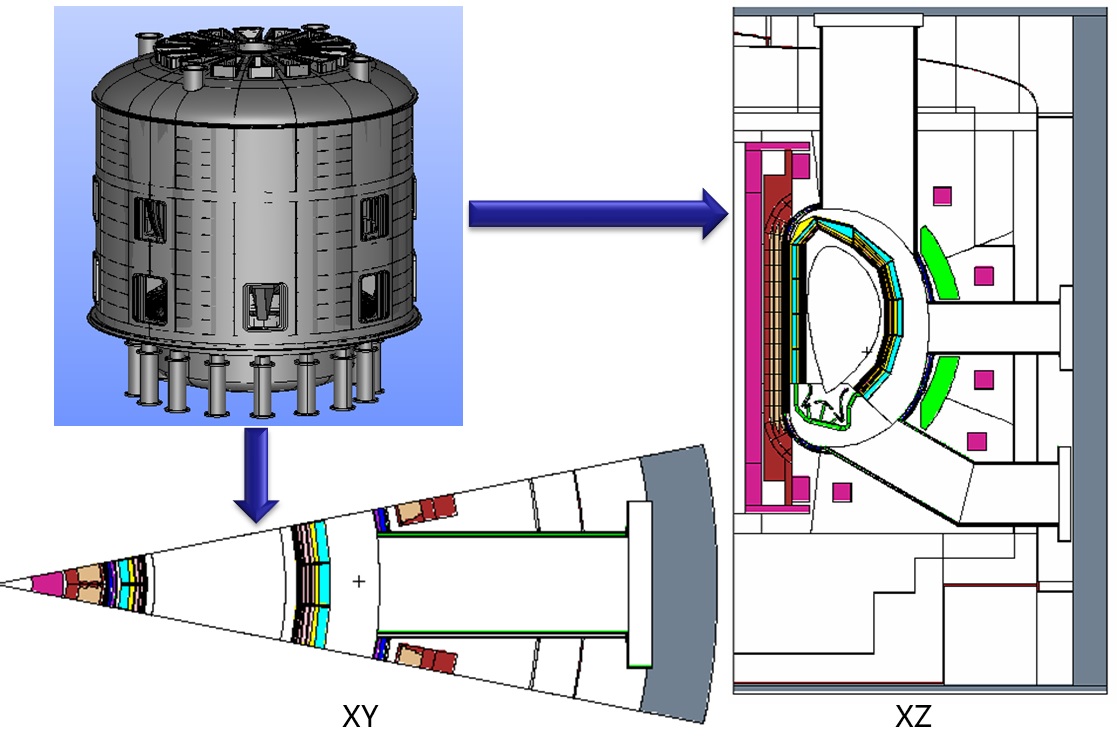Speaker
Description
The China Fusion Engineering Test Reactor (CFETR) is the next device in the roadmap for the realization of fusion energy in China, which aims to bridge the gaps between the fusion experimental reactor (ITER) and the demonstration reactor (DEMO). For the fusion reactor, the neutronic and shielding assessment is indispensable for the performance and safety design of the reactor, which strongly impact the key design features, such as tritium self-sufficiency, heat generation, activation of structural materials, shielding and radioactivity safety, etc. Based on the latest design of CFETR, the preliminary neutronic analysis for the major components of CFETR tokamak have been performed. The key nuclear parameters, such as tritium breeding ratio (TBR), neutron wall load of first wall, neutron flux, nuclear heating, burn-up of breeding material, activation data, material damage (dpa), gas production rate, etc., have been obtained and analyzed, also the impact on TBR by the ports of neutral beam injection (NBI) is studied. Meanwhile, the shielding performance is assessed and the optimization measures are proposed to improve the shielding capability to the key components of the CFETR tokamak.
Based on the current physics design and major components design of CFETR, three-dimensional neutronic analysis model including tritium breeding blanket, divertor, vacuum vessel, thermal shield, toroidal field (TF) coils, poloidal field (PF) coils, central solenoid (CS), cryostat, bio-shield and port models, has been developed to be used for neutronic and shielding analyses of CFETR. The neutronic analysis model represents a 22.5° regular sector model of CFETR with reflecting boundary and standard D-T neutron source.
The tritium breeding blanket (TBB) is one of the most important components of CFETR with functions of tritium breeding, heat generating and nuclear shielding. Currently, the helium cooled ceramic breeder tritium breeding blanket (HCCB TBB) is the primary option for CFETR, which adopts high pressure helium gas as coolant, ceramic lithium silicate as tritium breeder and beryllium as neutron multiplier. After several rounds of neutronic design and optimization, the TBR of HCCB TBB is 1.166 which could well meet the target value. If consider 3 NBI ports of CFETR, the TBR decreases to 1.116. After 10 years operation with 1 GW fusion power and 50% duty factor, the TBR of HCCB TBB reduces by 1.8%. The total nuclear heating of HCCB TBB is 1420 MW, which is removed through the helium cooling system and used to generate electricity. For other major components of CFETR tokamak, nuclear heating with a detailed distribution has been obtained too, which is the important input parameter for thermo-hydraulics analysis and safety analysis. According to the preliminary operation plan and maintenance plan of CFETR, the activity and decay heat of each major component of CFETR have been evaluated by means of particle transport and activation coupling calculation. These activation data can provide reference and basis for rad-waste classification and disposal of CFETR.
The major components of CFETR tokamak, including vacuum vessel, tritium breeding blanket, divertor, thermal shield, shall provide adequate shielding to ensure that the TF coils will not be damaged by irradiation during the whole life of CFETR. In order to assess the shielding performance of TF coils, the overall shielding performance of CFETR has been evaluated based on the three-dimensional neutronic analysis model. Nuclear parameters such as fast neutron fluence and nuclear heating have been calculated and analyzed for TF coils at different positions. The results show that the shielding performance of TF coils nearby divertor, NBI port and high magnetic field areas could not meet the design requirements comparing with the irradiation limits. Combined with the engineering design requirements of CFETR, the preliminary shielding design and optimization for the divertor, NBI port and inboard areas have been performed. After optimization, the shielding performance of CFETR could basically meet the design requirements of TF coils.
Meanwhile, neutronic analysis for the components and areas outside cryostat of CFETR is ongoing, which will provide the radiation field distribution for the tokamak building and the input for the shutdown dose rate analysis, etc.
Acknowledgements
This work was supported by the National Key R&D Program of China with grant numbers 2017YFE0300501 and 2017YFE0300503, and the National Natural Science Foundation of China with grant number 11905046.
Reference
[1] Y.X. WAN, J.G. LI, Y. LIU, et al., “Overview of the present progress and activities on the CFETR”, Nuclear Fusion, 2017, 57: 102009
[2] G. Zhuang, et al., Progress of the CFETR design. Nuclear Fusion, 2019, 59: 112010
[3] X.Y. WANG, X.H. WU, et al., “Design Progress of CFETR HCCB TBB”, presented at CFETR 2019 annual meeting, Huangshan, China, Sep.24-28, 2019
[4] X.H. Wu, et al., “Optimized Design and Engineering Analyses for HCCB Blanket of CFETR”, Presented at 27th International Conference of Nuclear Engineering, Tsukuba, Japan, May 19-24, 2019
| Affiliation | Southwestern Institute of Physics |
|---|---|
| Country or International Organization | China |


